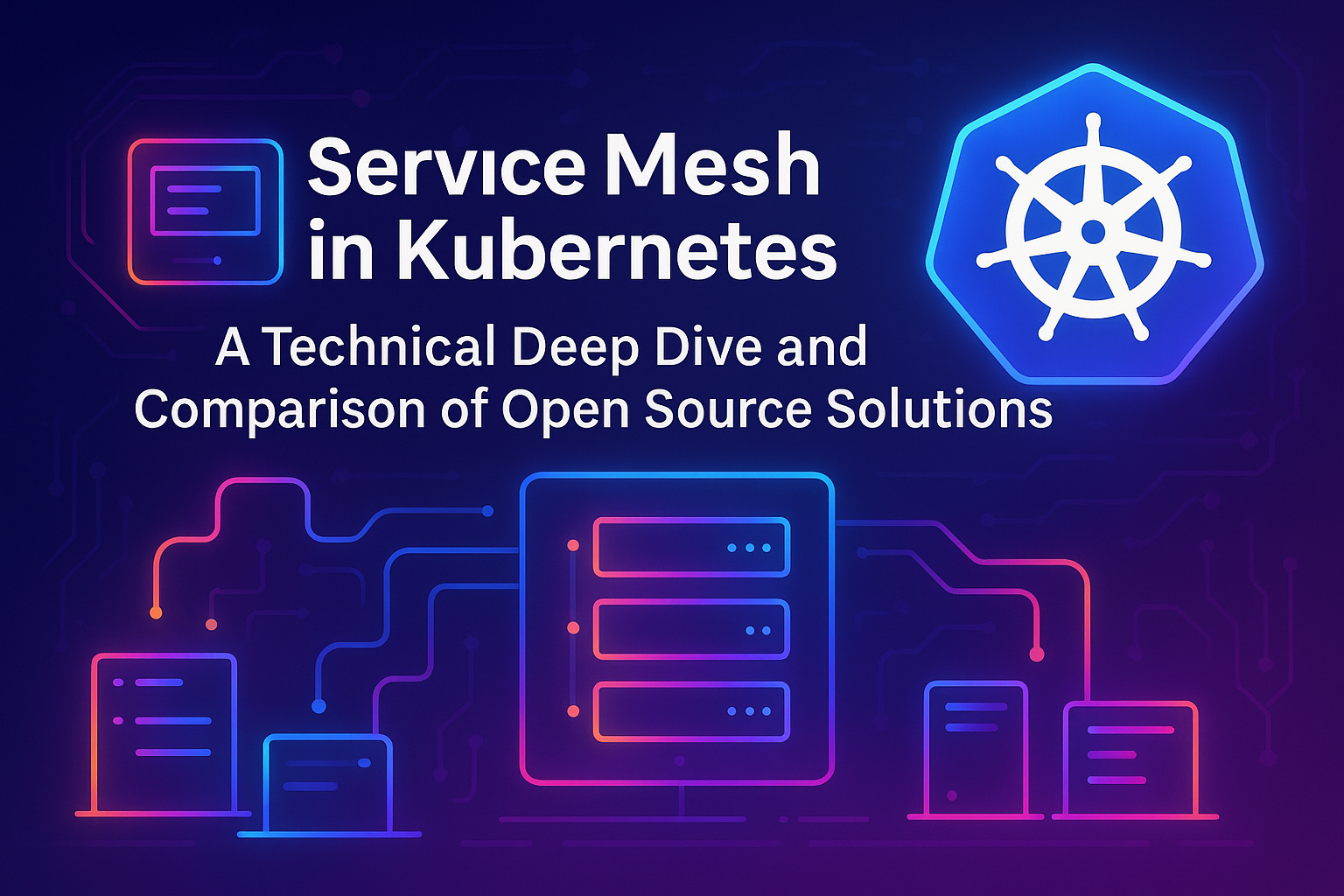Service Mesh in Kubernetes: A Technical Deep Dive and Comparison of Open Source Solutions
Kubernetes service mesh: securing, scaling, and steering microservice traffic with sidecars, zero-trust, and open source power.

Service mesh has emerged as a critical infrastructure layer for managing, securing, and optimizing service-to-service communication in Kubernetes environments. As organizations increasingly adopt microservices architectures, the complexity of managing these distributed components has created significant operational challenges. This technical exploration will examine the fundamental concepts behind service meshes, analyze the leading open source implementations, and provide detailed implementation considerations to help practitioners navigate this rapidly evolving landscape.
The Evolution of Service Communication in Cloud-Native Environments
The shift from monolithic applications to microservices has fundamentally changed how applications are built, deployed, and managed. In modern cloud-native environments, applications consist of dozens or even hundreds of independent services that must reliably communicate with one another. As these applications scale, the challenge of managing this communication becomes increasingly complex.
Traditional network management approaches fall short in dynamic Kubernetes environments where pods are ephemeral, constantly scaling up and down, and distributed across multiple nodes or clusters. Service mesh architecture emerged as a response to these challenges, providing a dedicated infrastructure layer specifically designed to handle service-to-service communication.
Understanding Service Mesh Architecture
A service mesh is a dedicated infrastructure layer built into an application that controls service-to-service communication in a microservices architecture. This layer handles critical networking functions including service discovery, load balancing, encryption, observability, and traffic management. Most importantly, it abstracts these complexities away from the application code itself.
Control Plane vs. Data Plane
Service meshes typically implement a two-component architecture:
-
Data Plane: Consists of lightweight proxy instances deployed alongside each service instance, typically as sidecar containers within Kubernetes pods. These proxies intercept all network traffic to and from the service, applying policies and collecting telemetry.
-
Control Plane: Manages and configures the proxies to enforce policies, collect metrics, and provide a management interface for operators. The control plane essentially orchestrates the behavior of all proxies in the mesh.
Linkerd describes this architecture succinctly: "Once Linkerd's control plane has been installed on your Kubernetes cluster, you add the data plane to your workloads (called 'meshing' or 'injecting' your workloads) and voila! Service mesh magic happens".
Sidecar Proxy Implementation
Most service meshes employ the sidecar proxy pattern, where a proxy container is deployed alongside each service instance. These proxies intercept all inbound and outbound traffic, enabling features like traffic routing, load balancing, and security policy enforcement without modifying application code.
Linkerd's implementation uses ultralight, transparent "micro-proxies" written in Rust and specifically optimized for Linkerd. As they describe: "Because they're transparent, these proxies act as highly instrumented out-of-process network stacks, sending telemetry to, and receiving control signals from, the control plane".
The Need for Service Mesh in Modern Kubernetes Deployments
Challenges of Managing Microservices at Scale
As applications scale to dozens or hundreds of microservices, several challenges emerge:
-
Service Discovery Complexity: The dynamic nature of Kubernetes means services are constantly being created, destroyed, and moved. As explained by HashiCorp: "Modern infrastructure is transitioning from being primarily static to dynamic in nature (ephemeral). This dynamic infrastructure has a short life cycle, meaning virtual machines (VM) and containers are frequently recycled. It's difficult for an organization to manage and keep track of application services that live on short-lived resources".
-
Security Requirements: Traditional perimeter-based security is insufficient for microservices. In modern distributed systems, services need mutual authentication and encrypted communication.
-
Observability Challenges: Understanding how services interact and identifying performance bottlenecks becomes exponentially more difficult as the number of services increases.
Network Complexity in Ephemeral Environments
Kubernetes' ephemeral nature compounds networking challenges. Services can be relocated, scaled, or restarted at any time, making traditional networking approaches insufficient. Service meshes address this by creating an abstraction layer that maintains consistent communication regardless of where services are physically located.
Core Capabilities of Service Mesh
Traffic Management and Routing
Service meshes provide sophisticated traffic management capabilities, including:
- Advanced routing: Route traffic based on headers, paths, or other request attributes
- Traffic splitting: Support for canary deployments and A/B testing
- Failover handling: Redirect traffic when services fail
- Rate limiting: Protect services from being overwhelmed
Istio, for instance, offers "fine-grained control of traffic behavior with rich routing rules, retries, failovers, and fault injection".
Security and Identity (mTLS and Zero-Trust)
Security is a primary concern in microservices architectures. Service meshes typically implement:
- Mutual TLS (mTLS): Automatic encryption and authentication of all service-to-service traffic
- Identity-based access: Services can only communicate if they have appropriate identity credentials
- Authorization policies: Fine-grained control over which services can communicate
A zero-trust security model is a common use case for service meshes. "In a zero trust model, applications require identity-based access to ensure all communication within the service mesh is authenticated with TLS certificates and encrypted in transit". This approach is particularly important in cloud environments where the traditional network perimeter is no longer well-defined.
Observability and Telemetry
Service meshes provide comprehensive visibility into service behavior:
- Metrics collection: Latency, traffic, errors, saturation metrics
- Distributed tracing: End-to-end request tracing across services
- Service dashboards: Visual representations of service health and performance
Linkerd automatically "collects metrics from all services that send traffic through it", while Istio provides "automatic metrics, logs, and traces for all traffic within a cluster, including cluster ingress and egress".
Resilience Features and Fault Tolerance
Service meshes enhance application reliability through:
- Circuit breaking: Prevent cascading failures by stopping traffic to failing services
- Retries and timeouts: Automatically retry failed requests with configurable backoff
- Fault injection: Test system resilience by simulating failures
Research by MeshInsight found that "service meshes can have high overhead" but also showed that adaptive circuit breaking mechanisms can "maintain tail response time below the given threshold 98% of the time (including cold starts) on average with an availability of 70%".
Comparing Leading Open Source Service Mesh Projects
Istio
Istio has emerged as one of the most feature-rich and widely adopted service mesh implementations.
Architecture and Components
Istio uses Envoy as its data plane proxy and provides a rich control plane for managing these proxies. It integrates deeply with Kubernetes but can also connect to VMs and other non-Kubernetes workloads.
Feature Set and Capabilities
Istio offers an extensive feature set, including:
- Support for HTTP1.1/HTTP2/gRPC/TCP protocols (all marked as "Stable")
- Advanced traffic control with label/content-based routing and traffic shifting
- Resilience features including timeouts, retries, connection pools, and outlier detection
- Comprehensive ingress and egress gateway functionality
- Prometheus integration for metrics and Grafana dashboards for visualization
- Distributed tracing capabilities
Performance Characteristics
Istio has been noted for its comprehensive feature set, but this comes with performance considerations. Research has shown that it "can have high overhead" and may "substantially increase application latency and resource consumption".
In comparative studies, Istio was found to have higher latency compared to some alternatives, with one study noting that "Linkerd performing 29.85% and 63.43% better than Cilium and Istio, respectively".
Use Cases and Best Fit Scenarios
Istio is particularly well-suited for:
- Large-scale, complex applications requiring advanced traffic management
- Environments with diverse protocol requirements
- Organizations with significant operational resources to manage the added complexity
- Multi-cluster deployments requiring advanced service discovery
Research confirms that "Istio excels in scalability and advanced traffic management, making it ideal for large-scale, complex applications".
Linkerd
Linkerd positions itself as a lightweight, performance-focused alternative to Istio.
Architecture and Design Philosophy
Linkerd has a minimalist design philosophy, focusing on simplicity and performance. Unlike Istio, which uses Envoy, Linkerd has developed its own micro-proxy written in Rust. This custom proxy is "designed to be as small, lightweight, and safe as possible".
Feature Set and Capabilities
Linkerd offers a focused feature set, including:
- HTTP, HTTP/2, and gRPC proxying with automatic advanced features
- TCP proxying with protocol detection
- Retries and timeouts for HTTP and gRPC requests
- Automatic mutual TLS encryption
- Telemetry and monitoring with automatic metrics collection
- Load balancing for HTTP, HTTP/2, and gRPC connections
- Authorization policies to restrict traffic between services
Performance Advantages
Linkerd has demonstrated significant performance benefits in multiple studies. Research shows that "Linkerd excels in RAM usage efficiency and low latency in application frontend management". Another study found Linkerd performing "29.85% and 63.43% better than Cilium and Istio, respectively" in terms of response times.
Use Cases and Best Fit Scenarios
Linkerd is particularly appropriate for:
- Teams prioritizing simplicity and ease of adoption
- Applications where performance is a critical concern
- Smaller, less complex deployments
- Organizations with limited operational resources
Research supports this, noting that "Linkerd, with its simplicity and high performance, is well-suited for smaller, less complex setups".
Other Noteworthy Service Mesh Solutions
Consul Connect
Consul offers a service mesh capability through Consul Connect. It stands out for:
- Strong service discovery features
- Effectiveness in hybrid cloud environments
- Efficient multi-cluster communication management
"Consul, known for its strong service discovery features, is particularly effective in hybrid cloud environments, efficiently managing multi-cluster communication".
Kuma/Kong
Kuma offers flexibility across diverse environments:
- Built-in multi-cluster capabilities
- Support for both Kubernetes and non-Kubernetes environments
- Flexibility for heterogeneous deployments
"Kuma stands out for its flexibility, supporting both Kubernetes and non-Kubernetes environments, and offers built-in multi-cluster capabilities".
Cilium (Sidecarless Approach)
Cilium takes a different architectural approach by leveraging eBPF technology to implement service mesh capabilities without sidecars.
"This paper aims to explore the eBPF-based service mesh, Cilium, which eliminates the need for a sidecar while encompassing most service mesh capabilities".
This approach addresses some of the performance overhead concerns associated with the sidecar model, although performance results have been mixed, with Linkerd still showing better response times in some scenarios.
Implementation Considerations
Performance Overhead Analysis
Implementing a service mesh introduces performance overhead that must be carefully considered:
-
Latency Impact: Adding proxies to the request path inevitably increases latency. Research has shown that "service meshes can...substantially increase application latency".
-
Resource Consumption: Service meshes require additional compute resources. The MeshInsight study confirmed that service meshes can "substantially increase...resource consumption".
-
Protocol Considerations: Performance impact varies by protocol. HTTP/2 and gRPC typically see less relative overhead compared to HTTP/1.1.
-
mTLS Overhead: Enabling mutual TLS adds security but impacts performance. As noted in research: "we investigate the impact of the mTLS protocol - a common security and authentication mechanism - on application performance within service meshes".
Sidecar vs. Sidecarless Approaches
The traditional sidecar proxy model has trade-offs that newer approaches aim to address:
-
Sidecar Challenges: "Data planes in most service meshes are implemented using sidecar proxies, posing specific challenges when injected into application pods".
-
eBPF Alternatives: "A potential solution to these challenges lies in the sidecarless approach", as implemented by Cilium.
-
Performance Comparisons: While sidecarless approaches promise lower overhead, empirical results have been mixed. One study found that "Linkerd outperforms other solutions with respect to response times, with Linkerd performing 29.85% and 63.43% better than Cilium and Istio, respectively".
Multi-Cluster and Multi-Region Deployments
Service meshes offer varying levels of support for complex deployment scenarios:
-
Multi-Cluster Capabilities: Several meshes now support multi-cluster deployments. "Istio is designed for extensibility and can handle a diverse range of deployment needs... extend the mesh to other clusters, or even connect VMs or other endpoints running outside of Kubernetes".
-
Federation Models: Different service meshes implement different federation models for connecting multiple meshes across clusters or regions.
-
Comparative Analysis: "This study compares these leading service meshes based on scalability, security, ease of use, performance, and operational complexity" for multi-cluster environments.
Operational Complexity
Implementing a service mesh adds operational overhead:
-
Additional Control Plane: "A service mesh adds operational complexity and introduces an additional control plane for teams to manage".
-
Maintenance Requirements: Service meshes require ongoing maintenance, including updates, security patches, and performance tuning.
-
Learning Curve: Teams must develop expertise in service mesh concepts, tools, and troubleshooting approaches.
Specialized Use Cases and Advanced Features
Zero-Trust Security Implementation
Service meshes are instrumental in implementing zero-trust security models:
-
Identity-Based Authentication: Every service requires identity verification before communication is allowed.
-
Encryption in Transit: All service-to-service communication is automatically encrypted.
-
Application to 5G Networks: Research has explored "the potential threat of Distributed Denial of Service (DDoS) and specifically, flooding attacks that can wreak havoc on the 5G mobile infrastructure as well as design a solution according to the zero-trust security model".
Circuit Breaking and Fault Injection
Advanced resilience features offer sophisticated system protection:
-
Adaptive Circuit Breaking: Research has demonstrated that "an adaptive circuit breaking mechanism, implemented through an adaptive controller... keeps the tail response time below a given threshold while maximizing service throughput".
-
Performance Management: Circuit breaking can evolve "from panic button to performance management tool" when implemented intelligently.
-
Testing Resilience: Fault injection capabilities allow teams to proactively test system resilience by simulating failures in a controlled manner.
Selecting the Right Service Mesh: Decision Framework
When evaluating service mesh options, consider these key factors:
-
Application Scale and Complexity: Larger, more complex applications may benefit from Istio's rich feature set, while smaller deployments may prefer Linkerd's simplicity and performance.
-
Performance Requirements: If minimizing latency is critical, consider performance benchmarks that show "Linkerd excels in RAM usage efficiency and low latency in application frontend management".
-
Operational Resources: Assess your team's capacity to manage additional complexity. "A service mesh adds operational complexity and introduces an additional control plane for teams to manage".
-
Multi-Cluster Requirements: For multi-cluster deployments, evaluate specific capabilities. "In modern cloud-native applications, managing communication across multiple Kubernetes clusters can be complex. Service meshes, such as Istio, Linkerd, Kuma, and Consul, help address challenges like service discovery, traffic routing, security, and observability in multi-cluster environments".
-
Protocol Support: Ensure the service mesh supports your application's communication protocols with appropriate maturity levels.
Future Directions in Service Mesh Technology
The service mesh landscape continues to evolve rapidly, with several emerging trends:
-
Reduced Overhead: Ongoing research aims to minimize the performance impact of service meshes through optimized proxies and sidecarless approaches.
-
eBPF Integration: Technologies like eBPF are enabling new approaches to implementing service mesh functionality with potentially lower overhead.
-
Standardization: Efforts to standardize service mesh APIs and interfaces are gaining momentum, potentially increasing interoperability between implementations.
-
Edge Computing Integration: Service mesh concepts are extending to edge computing scenarios, addressing the unique challenges of highly distributed applications.
-
WebAssembly Extensibility: Support for WebAssembly is enabling more flexible, secure extension mechanisms for service mesh proxies.
Service mesh technology represents a critical evolution in cloud-native networking, providing the sophisticated communication layer needed for complex, distributed applications. As with any technology decision, carefully evaluating your specific requirements against each implementation's strengths and limitations is essential for successful adoption. The service mesh landscape will continue to mature, but the fundamental value proposition - abstracting and enhancing service-to-service communication - remains a cornerstone of modern cloud-native architecture.

